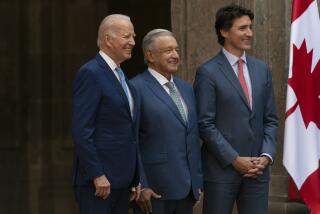Negotiations on Latin Debt End in Standoff : $400 Billion Owed; U.S. Opposes Easing of Terms
- Share via
MEXICO CITY — The United States and debtor countries meeting here last month wrestled with proposals to ease the $400-billion foreign debt that burdens Latin America and the Caribbean, but ended the sessions at odds over how best to overcome long-running economic problems in the developing countries.
The Latin and Caribbean countries, led by Mexico, pressed for easier terms of debt payment. They asked that payments be adjusted to “each country’s real capacity to pay” and suggested that the level of debt repayment be tied to a percentage of the earnings a country makes from exports or to some other economic variable.
The United States, meanwhile, pressed for the debtors to open their countries to foreign trade and investment as an engine for economic growth that in turn would make debt repayment easier.
In effect, the argument over the debt problem, which sapped $32 billion in interest payments from the countries of Latin America and the Caribbean last year, is at a standoff. The United States insists, under a plan first formulated by Treasury Secretary James A. Baker III, on measured doses of new loans coupled with reforms in the debtor countries. The debtors concede the need for reforms, but want more relief.
Positive Result
The proposals came at the end of a weeklong meeting of the U.N. Economic Commission for Latin America and the Caribbean, known widely as CEPAL, its acronym in Spanish. The 32 participants met amid reports that debtors might take a strong stand toward repayment of loans taken out during the past 15 years. Refusal to pay up could badly damage the U.S. banks that made a large portion of the loans.
There was little talk of unilaterally breaking off payments to foreign banks, although that was not a reflection of the debtor nations being content.
“An international financial crisis has been resolved, which constitutes a positive result,” said Norberto Gonzalez, executive secretary of CEPAL. “But . . . relief of the weight of debt has not been obtained.”
Such frustration was evident in an annex issued by debtor nations to the official report of the meeting.
“At a high political and social cost, we have made a major effort to adjust our economies,” the annex said. “However, even this sacrifice has not allowed us to simultaneously service the debt and achieve the aims of development.”
U.S. Resistance
Mexico, which called the meeting, was clearly taking the lead in the search for easier payments. The phrase “each country’s real capacity to pay” was drawn from a 1986 speech on debt renegotiation by Mexican President Miguel de la Madrid.
U.S. representatives resisted any attempt at a blanket solution to the debt problem and said the debtors overemphasized “external factors” as the source of regional ills. In contrast, the U.S. delegates argued that internal laws in debtor nations that restrict foreign investment or scare away domestic money are at fault.
“We emphasize, as one important element in our approach, new equity investment, whether domestic-based, in the form of direct foreign investment, or as the re-flow of flight capital,” the U.S. response said.
The past year has been a mixed one for Latin economies. Unlike the early 1980s, when the economies of the region uniformly sank into recession, several economies prospered in 1986, according to a CEPAL report published in December.
Growth or stagnation depended mainly on whether countries benefited from falling oil prices. Oil-importing countries or nations not dependent on petroleum exports to buttress their economies fared well. But countries in which oil exports account for a large percentage of export sales generally suffered declines.
Aversion to IMF
Overall, Latin America’s gross domestic product grew by 3.4%. Those of non-oil exporting countries grew by 6.5%. The economies of oil exporters shrank by 2%.
Several countries, whether they fared well or badly, gathered around one rallying point: aversion to dealing with the International Monetary Fund, whose blessing is usually needed for major foreign loans or restructuring of old debt. The IMF often imposes conditions on the country receiving new money or new terms of repayment. Many governments resent such “conditionality,” which often includes demands for reduced government spending.
More to Read
Sign up for Essential California
The most important California stories and recommendations in your inbox every morning.
You may occasionally receive promotional content from the Los Angeles Times.










